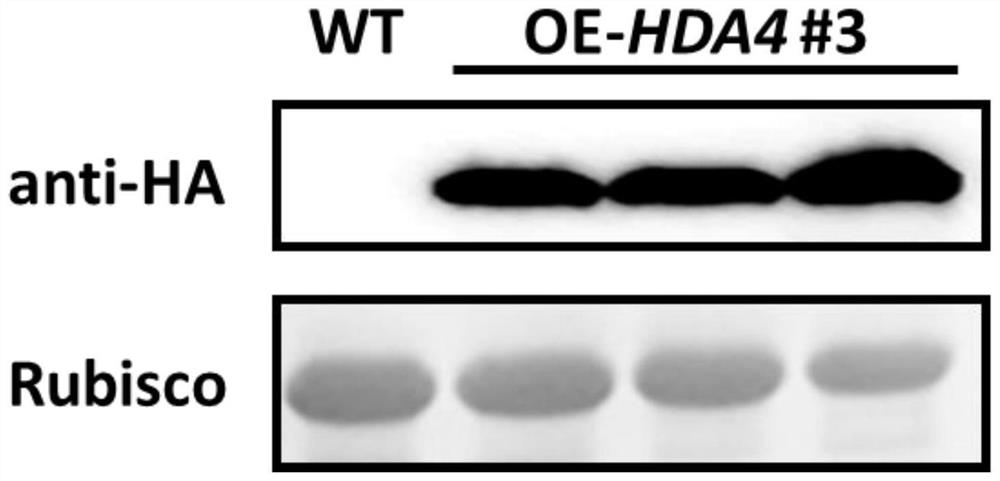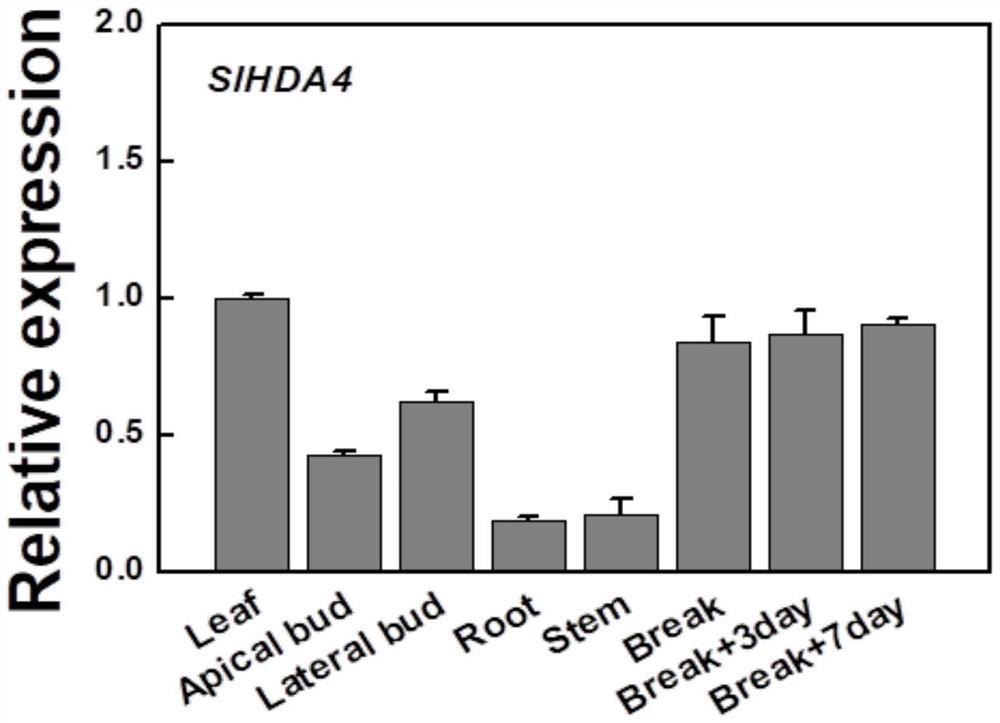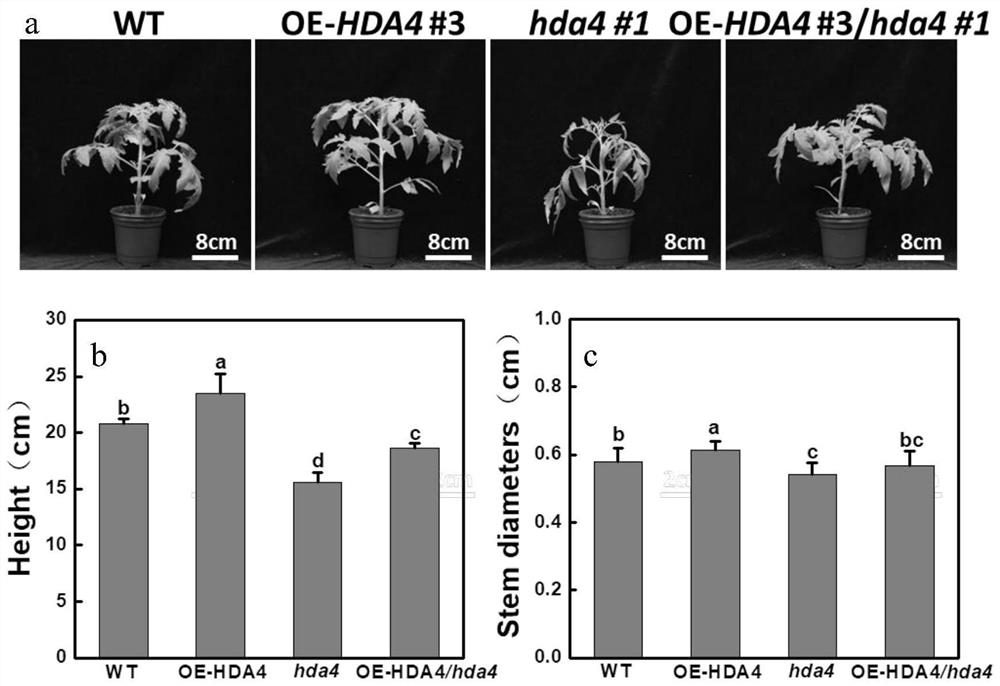Application of SlHDA4 gene in cultivation of apical dominance enhanced tomato germplasm
An apical dominance and enhanced technology, applied in application, genetic engineering, plant genetic improvement, etc., can solve the problems of decreased IAA content and inability to completely suppress side buds, etc., to increase auxin content, enhance apical dominance, and reduce the workload of pruning Effect
- Summary
- Abstract
- Description
- Claims
- Application Information
AI Technical Summary
Problems solved by technology
Method used
Image
Examples
Embodiment 1
[0036] Embodiment 1 SlHDA4 gene transgenic plant acquisition
[0037] One, the construction of SlHDA4 gene overexpression vector
[0038] In order to promote the innovation of tomato apical dominance-enhanced germplasm and explore the function of histone deacetylases in tomato side branching, the SlHDA4 gene was cloned from the tomato genome database, and its code is Solyc11g067020. According to the SlHDA4 coding region sequence, the multiple cloning site of the overexpression vector pFGC1008-HA and its surrounding sequences, select restriction enzyme sites (AscI and KpnI) and design homology arms, and use the software CE DesignV1.03 to generate specific primers The sequences of SlHDA4-F (ttacaattaccatggggcgcgccATGAGGTCCAAGGACAAAATCTCC) and SlHDA4-R (aacatcgtatgggtaggtaccGGCATCATCAGTGTGGTTATCG) are shown in SEQ ID NO.3 and SEQ ID NO.4, respectively.
[0039] Use KOD high-fidelity enzyme PCR to amplify the SlHDA4 fragment, purify and recover the PCR product, perform double enz...
Embodiment 2
[0042] Example 2 Acquisition of SlHDA4 Gene Knockout Plants
[0043] 1. Construction of SlHDA4 Gene CRISPR / Cas9 Gene Knockout Vector
[0044] To explore the effect of SlHDA4 deletion on tomato collateral formation, we designed the sgRNA sequence of SlHDA4, constructed pCAMBIA1301-U6-26-sgRNA-SlHDA4-35S-cas9SK vector, and knocked out SlHDA4 by CRISPR / Cas9 technology for research.
[0045] Design the target sequence of the SlHDA4 gene through the website (https: / / www.genome.arizona.edu / crispr / CRISPRsearch.html) CRISPR-P, and add BbsI restriction endonuclease sticky ends (aaaatctcctacttctacga) at both ends, the specific sequence As shown in SEQ ID NO.5. Anneal the synthetic single-stranded sgRNA sequence to form double-stranded sgRNA. The CRISPR vector U6-26-sgRNA-35S-cas9SK was single-digested with BbsI restriction endonuclease. use T 4 Ligase connects the sgRNA to the linearized U6-26-sgRNA-35S-cas9SK vector, sends it to the sequencing company for sequencing, and extracts t...
Embodiment 3
[0048] Example 3 qRT-PCR analysis of the expression of SlHDA4 gene in different tissues and organs of tomato
[0049] Using qRT-PCR to study the expression pattern of SlHDA4 gene, the specific method of qRT-PCR is as follows:
[0050] use 480II fluorescent quantitative PCR instrument (Roche, Swiss) was used for detection. For details of the reaction system, refer to the instruction manual of 2×SYBR Green Supermix (Vazyme). The specific primers of SlHDA4 gene are (RT-SlHDA4-F: 5'-TAAATTGGGCTGGTGGCTTG-3'; RT-SlHDA4-R: 5'-CCCGCGGATGATACTTCAGA-3'), referring to the method of Livak and Schmittgen (Livak, K.J.and Schmittgen, T.D.Analysis of Relative GeneExpression Data Using Real-Time Quantitative PCR and the 2ΔΔC TMethod.Methods, 2001,25(4):402-408.), using 2 -ΔΔCt Calculation of relative expression levels of genes.
[0051] The results showed that SlHDA4 was expressed in different tissues, with the highest expression in leaves and relatively low expression in roots and stems ...
PUM
 Login to View More
Login to View More Abstract
Description
Claims
Application Information
 Login to View More
Login to View More - R&D
- Intellectual Property
- Life Sciences
- Materials
- Tech Scout
- Unparalleled Data Quality
- Higher Quality Content
- 60% Fewer Hallucinations
Browse by: Latest US Patents, China's latest patents, Technical Efficacy Thesaurus, Application Domain, Technology Topic, Popular Technical Reports.
© 2025 PatSnap. All rights reserved.Legal|Privacy policy|Modern Slavery Act Transparency Statement|Sitemap|About US| Contact US: help@patsnap.com



